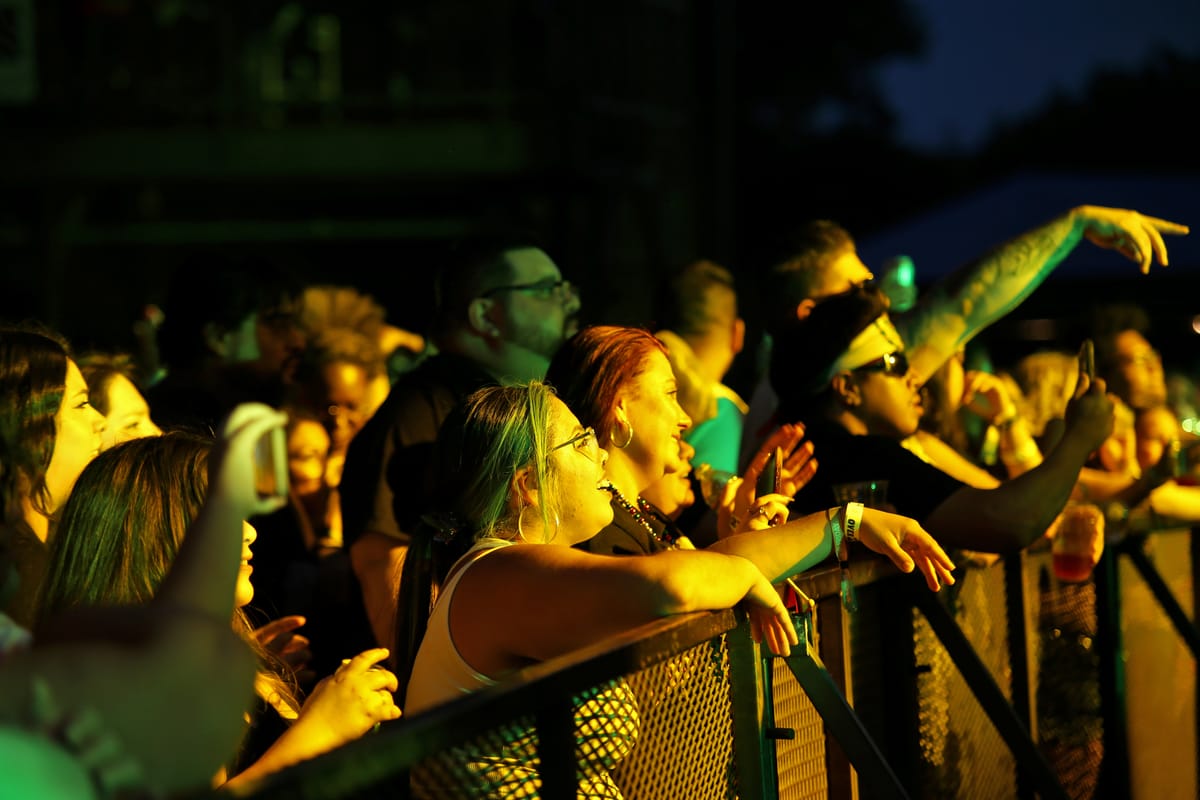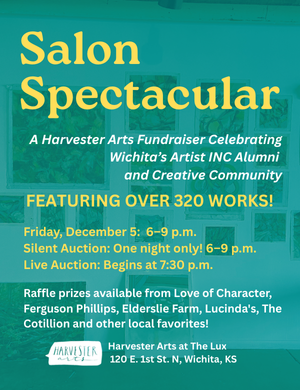Unstable territories on earth and beyond: Susan Hiller, Hugo Zelada-Romero, and Terry Evans at the Salina Art Center
Summer exhibitions showcase UFO stories from far and near and photographs of what’s beneath our feet. “High Strangeness: Encounters with the Unexplained in Kansas and Beyond” and "Tales of Dakota Sandstone" are on view through August 31.

Two exhibitions made up primarily of photography, plus a major audio piece, offer visitors to the Salina Art Center stories that exist in the spaces between knowing and not knowing. The two artists who created “High Strangeness: Encounters with the Unexplained in Kansas and Beyond” and the photographer behind “Tales of Dakota Sandstone” use art as a research tool to define and investigate life’s mysteries.
Terry Evans, formerly of Salina now working in Chicago; Hugo Zelada-Romero, also of Chicago; and American-born British artist Susan Hiller, who died in 2019, share related concerns. These shows are evidence of their artistic courage to step into the familiar world and face its simultaneously extraordinary nature. They employ visual, written, and auditory narratives and use the tools of anthropology, ethnography, geology, and natural history to produce these compelling bodies of work.
In these exhibitions, text is as important as the photographs and sound. Viewers are invited to walk around in a layered environment of words, symbols, and images. Mimicking the methodologies of Hiller and Zelada-Romero, the Art Center continues to solicit eyewitness stories of UFO or other anomalous experiences through July 1 for a future reading. This is part of a robust set of programs that include artist talks, a road trip, a philosophy lecture, film screenings, and storytelling (for a complete list with dates, see below).
Susan Hiller
Like a good open-mic poetry reading, the voices in Hiller’s “Witnesses” combine to create a democracy of expression, each voice narrating an out-of-the-ordinary and perhaps beyond-earthly encounter.
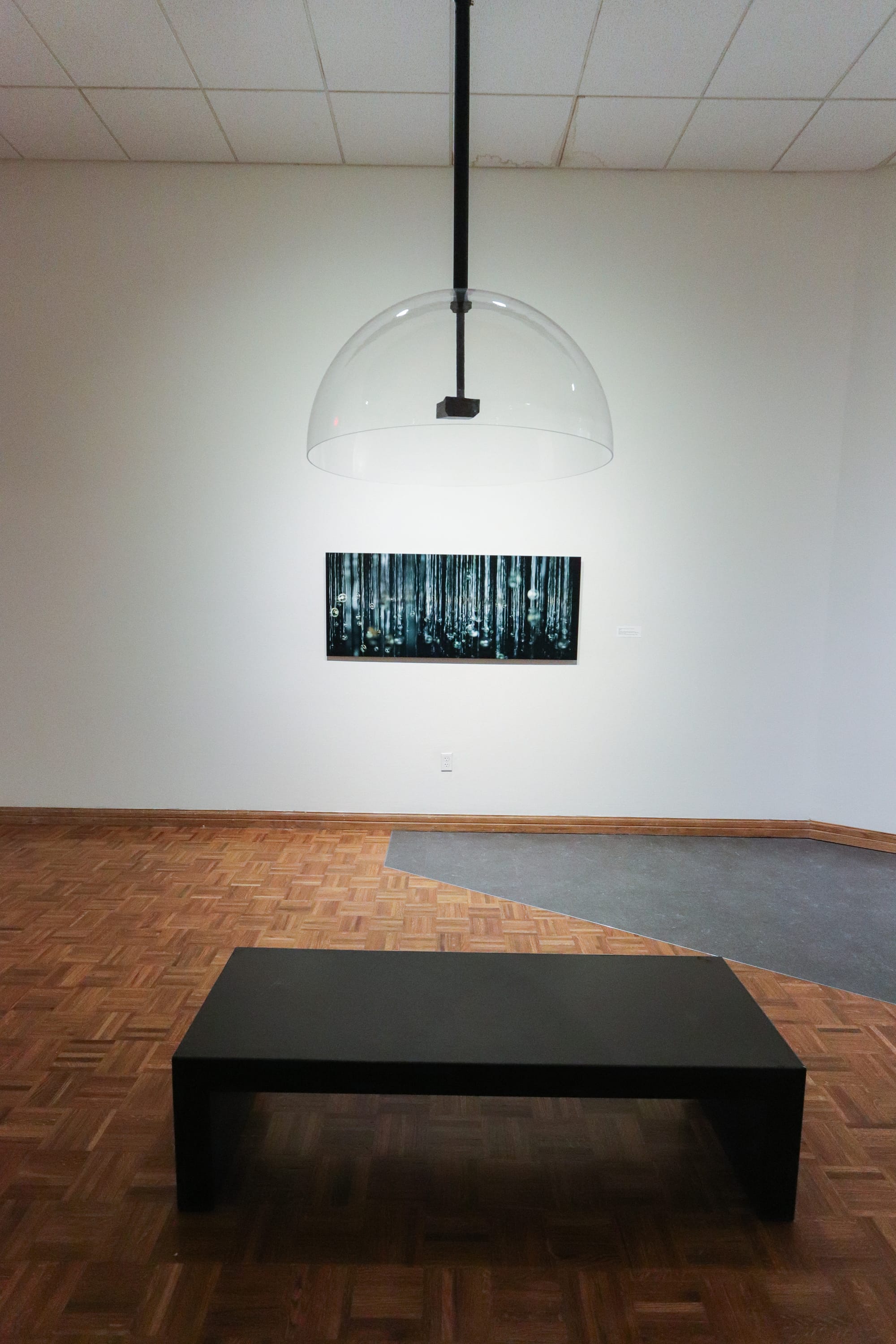
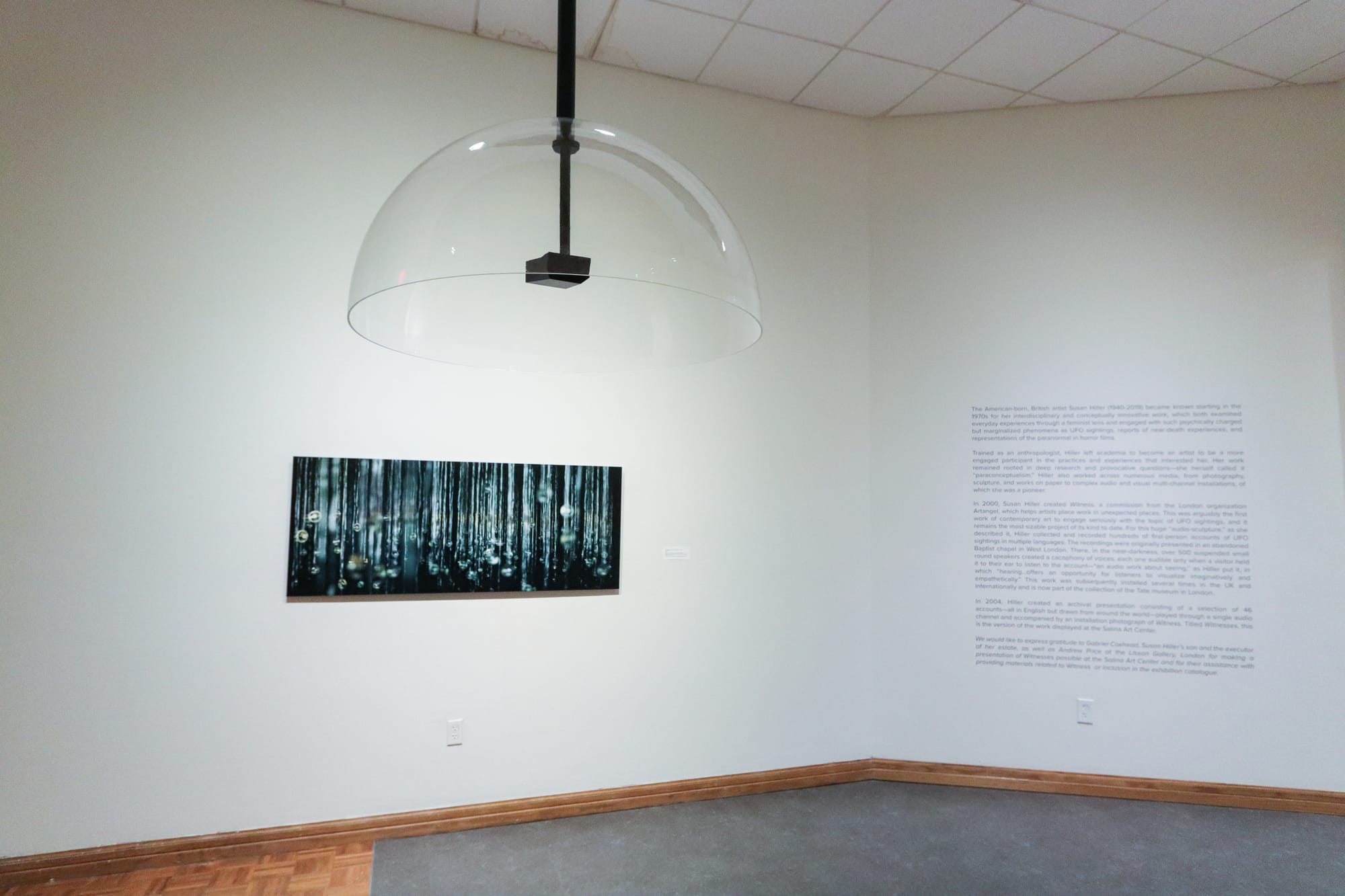
Susan Hiller, “Witnesses,” sound installation at the Salina Art Center. Photograph 25 by 61 inches, courtesy of the Estate of Susan Hiller and Lisson Gallery, London. Photos courtesy of the Salina Art Center.
Hiller’s 2004 audio installation contains the voices of 46 individuals from around the world collected from the internet and from the police, army, and other investigative bodies. Each person seems to read from their own written recollections. In often both poetic and apprehensive retellings, these stories of UFOs come from all over the world, including Australia and New Zealand, Chile and Brazil, Great Britain, Italy, Croatia, France, Belarus, China, Japan, Zimbabwe, South Africa, Mexico, and the United States. A man from Tampa, for instance, remembers a cool Florida night when he was out walking his dog and suddenly, “this intense light” he describes as “so fast and bright” appeared from the “clear, bright sky and many stars.” Hiller was trained as an anthropologist. “Witnesses” is the second iteration of an audio sculpture she presented in England in the year 2000. This piece included 500 small, round speakers hanging from a ceiling, each transmitting a single voice, and a photograph of this work accompanies the Art Center’s installation. Listeners face a mysterious image of blue and black raindrop-like speakers on wires while sitting on a bench under a sound dome. To hear the whole piece, plan to spend a bit longer than an hour.

Independent curator Ksenya Gurshtein, of Wichita, calls Hiller’s piece “arguably the first work of contemporary art to engage seriously with the topic of UFO sightings.” When Gurshtein encountered Zelada-Romero’s “Objects That Whizz By” photographs accompanied by eyewitness accounts in Wichita, she was reminded of seeing “Witness” in London. This birthed the Art Center’s “High Strangeness” exhibition. In the exhibition catalog, Gurshtein’s writes that her goal with this show is “advocating for a culture of greater openness in our society for talking about UAP experiences (among other things about which I think there should be more openness), rooted in the idea that people’s lived experiences should be treated with a basic respect even in cases when we don’t understand it or might disagree with their own interpretation of it.”
Gurshtein’s catalog for “High Strangeness” not only documents the exhibition but extends it. For example, QR codes invite viewers to access video and audio components as well as an augmented reality sculpture by Zelada-Romero and Emily Baird in which an Unidentified Anomalous or Aerial Phenomena (UAP) appears and disappears in virtual reality space. The sculpture is also available inside the gallery, and soon will be accessible outside.

Hugo Zelada-Romero
Photographs with accompanying text, sculpture, and an installation fill two large galleries at the Art Center with Zelada-Romero’s exuberant exploration of UAPs. He is a first-generation American from Guatemala who was educated and began his research at Wichita State.
Like eyewitnesses reaching for the right words to persuade us and perhaps themselves of the truth of their experiences, Zelada-Romero’s artistic production stretches beyond written accounts and photographs, and his inspirations include pop culture, podcasts, film, books, and online UFO subcultures.
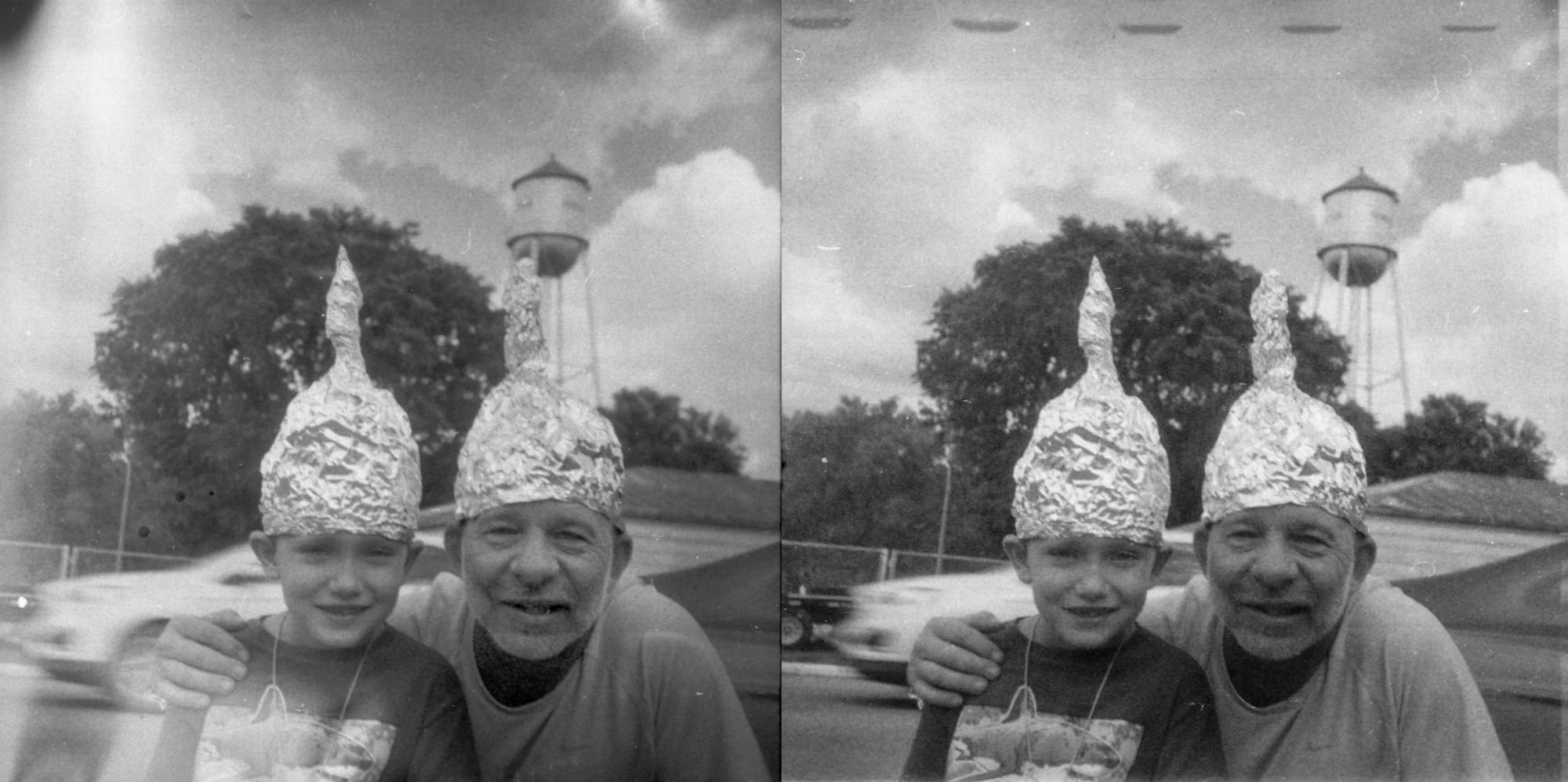
Belief, description, and verification are key aspects of these works. A pair of digital photographs related to a Kansas City, Kansas, man’s experience stand out. A large portrait of the man and his dog, titled “Jacob Everest with His Dog, Sky, Kansas City, KS” is surmounted by a motorized spinning disk of images that blur by too quickly to identify. An accompanying large photograph, “Reenactment of Jacob’s CE5 Experience in Kansas City, KS,” shows a creek or river, leafy vegetation, a cloudy sky, and a bright light hovering in the trees. Everest’s complete description of his experience are available in the exhibition catalog and in a file accessible in the gallery. In his description, Everest writes, “I definitely had a telepathic experience and astral projected into a spacecraft where I saw ‘entities’ …. I know it communicated to me a little excerpt through conscious telepathy when I was in the shower.” He adds that his phone and television were also affected after the experience.
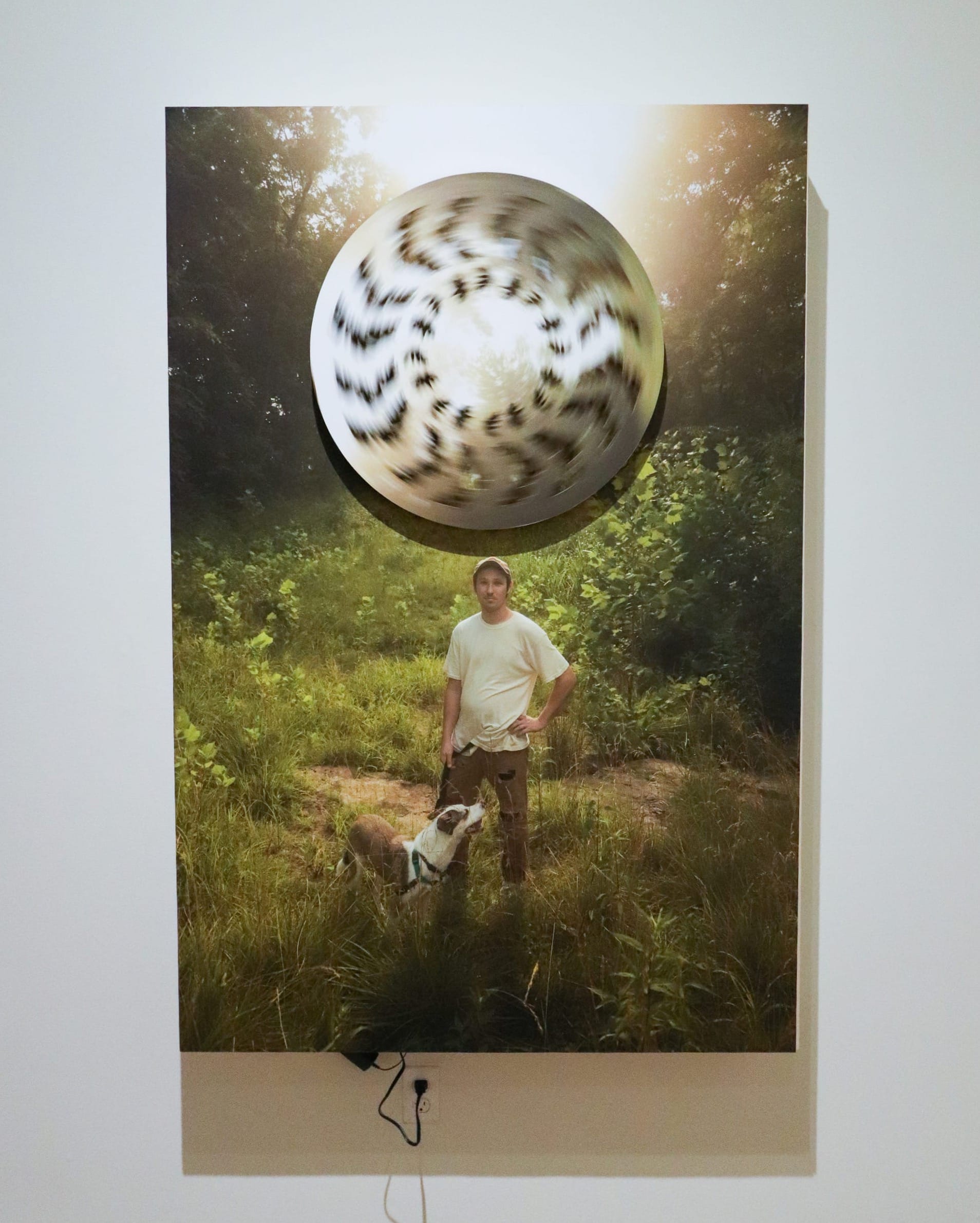
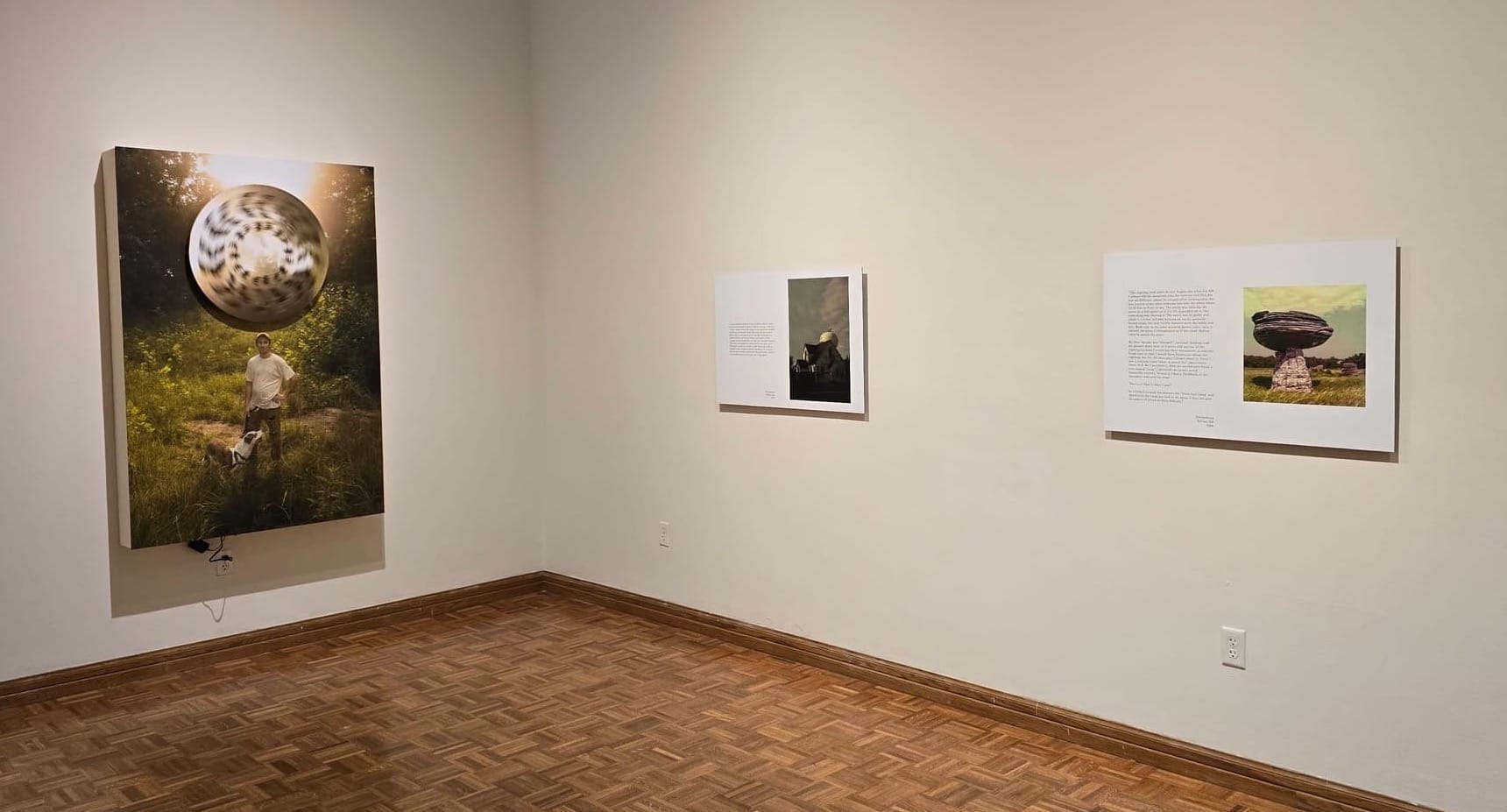
First-person accounts of UAP events, presented as text next to ten photographs made at sites where the phenomena occurred in Kansas, are from the artist’s 2018-2024 series “Objects That Whizz By in Pursuit of Their Own Illusive Identities.” Written accounts by these anonymous individuals, identified only by the town and date of the experience, range from scientific to casual. A subtext in many of the narratives is the quality of memory, famously unreliable, when what is being recounted has little connection to daily experience.
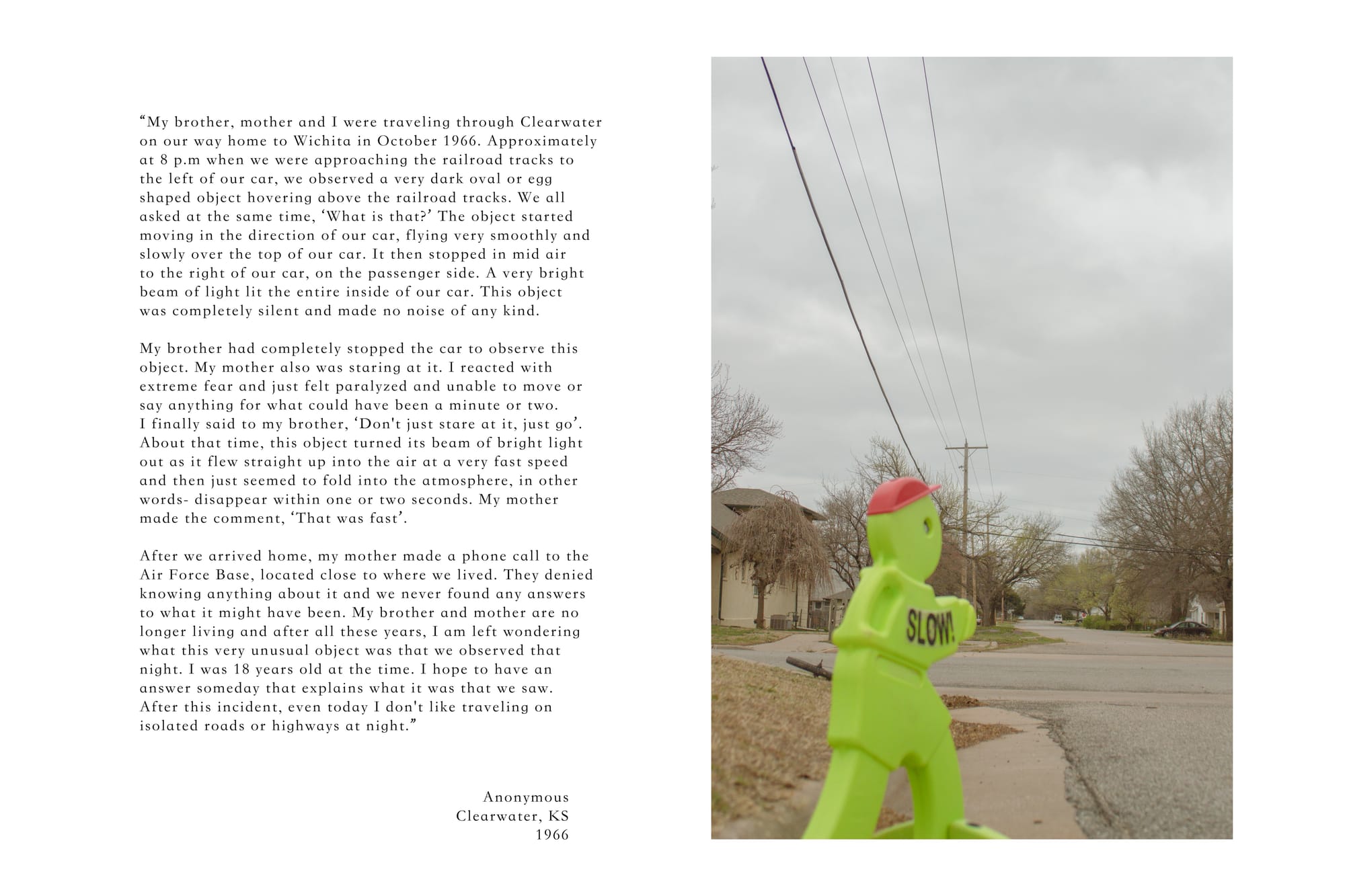
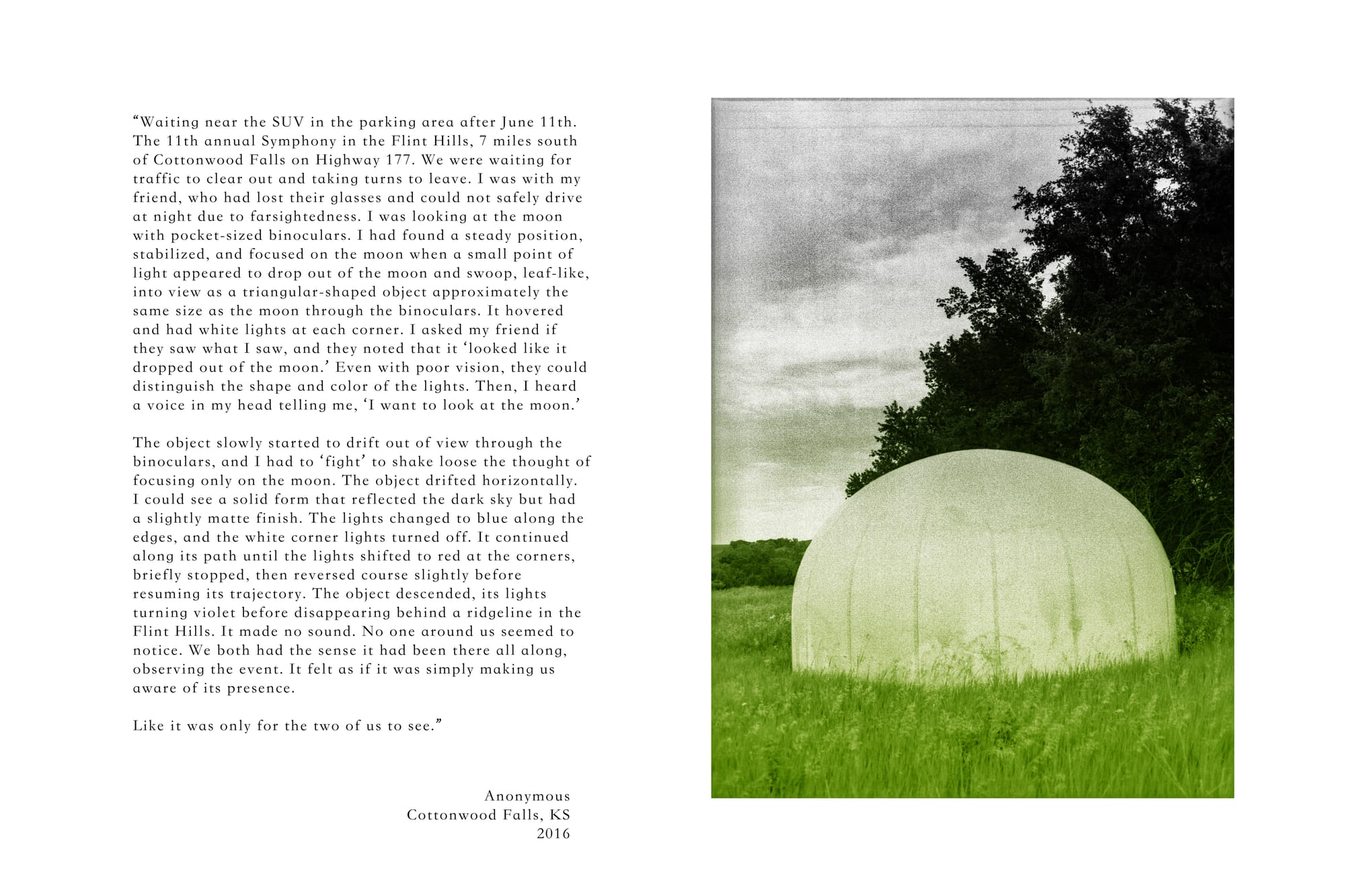
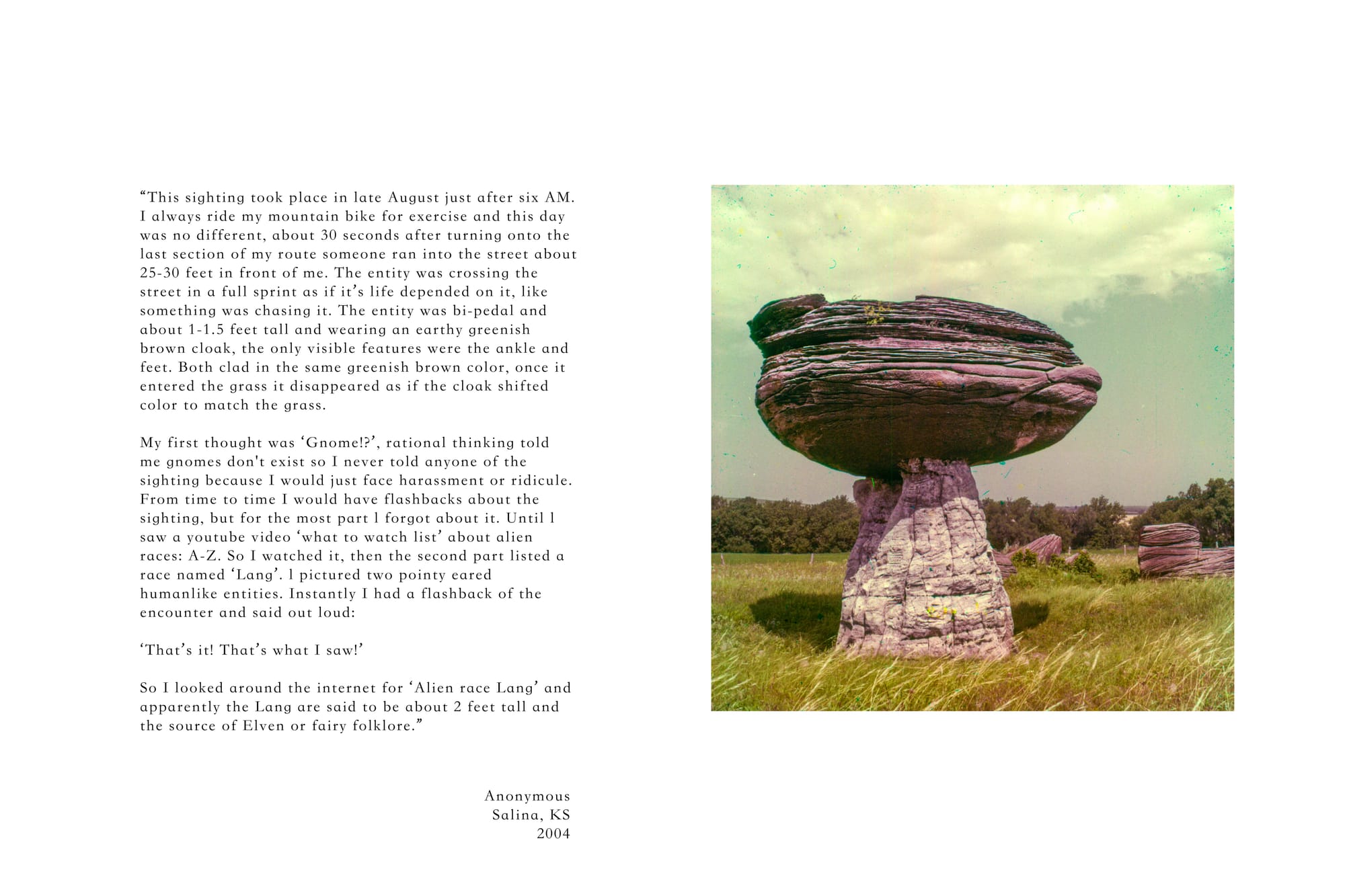
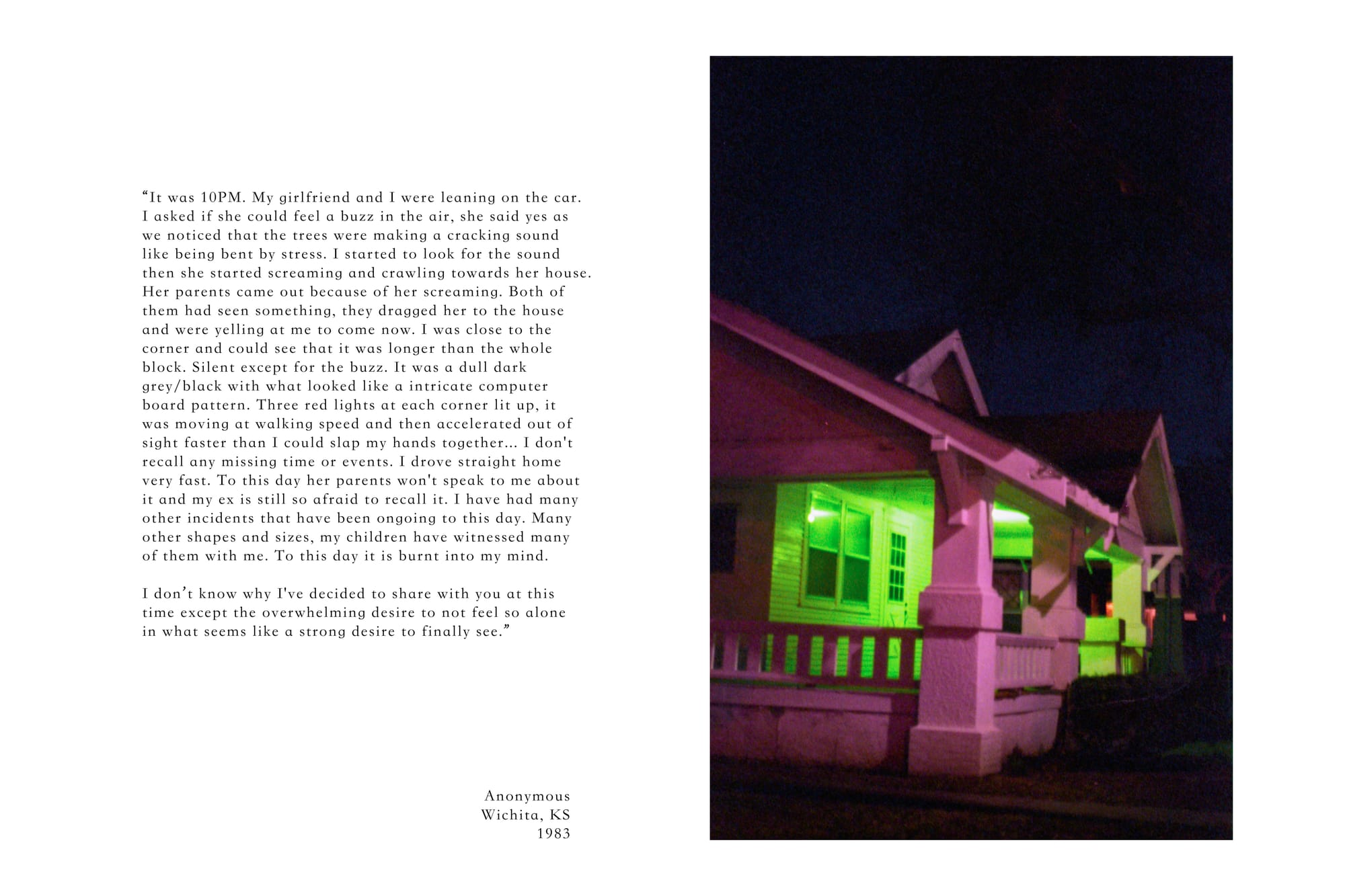
Pieces from Hugo Zelada-Romero’s series "Objects that Whizz By in Pursuit of Their Own Illusive Identities." Each are 24 by 36 inches. Images courtesy of the artist.
Zelada-Romero proposes that our long-term cultural fascination with UFOs/UAPs, and perhaps the experiences themselves, are related to or explained by a more familiar religious or spiritual framework. His video piece, “Synchronicity,” pairs found video of holy dirt at Santuario de Chimayo in New Mexico with drone video of the Johnson family farm in Delphos, site of a 1971 spacecraft landing and subsequent anomalous experiences. The film references newspaper articles immediately after the sighting when Ronnie Johnson, age 15 at the time, and his parents witnessed a bright, loud flying mushroom-shaped object near their farm. They report that it left a glowing circle on the ground where it hovered. When Ronnie’s mother touched the circle, she noticed an unusual odor, and soon after, her fingers became permanently numb.
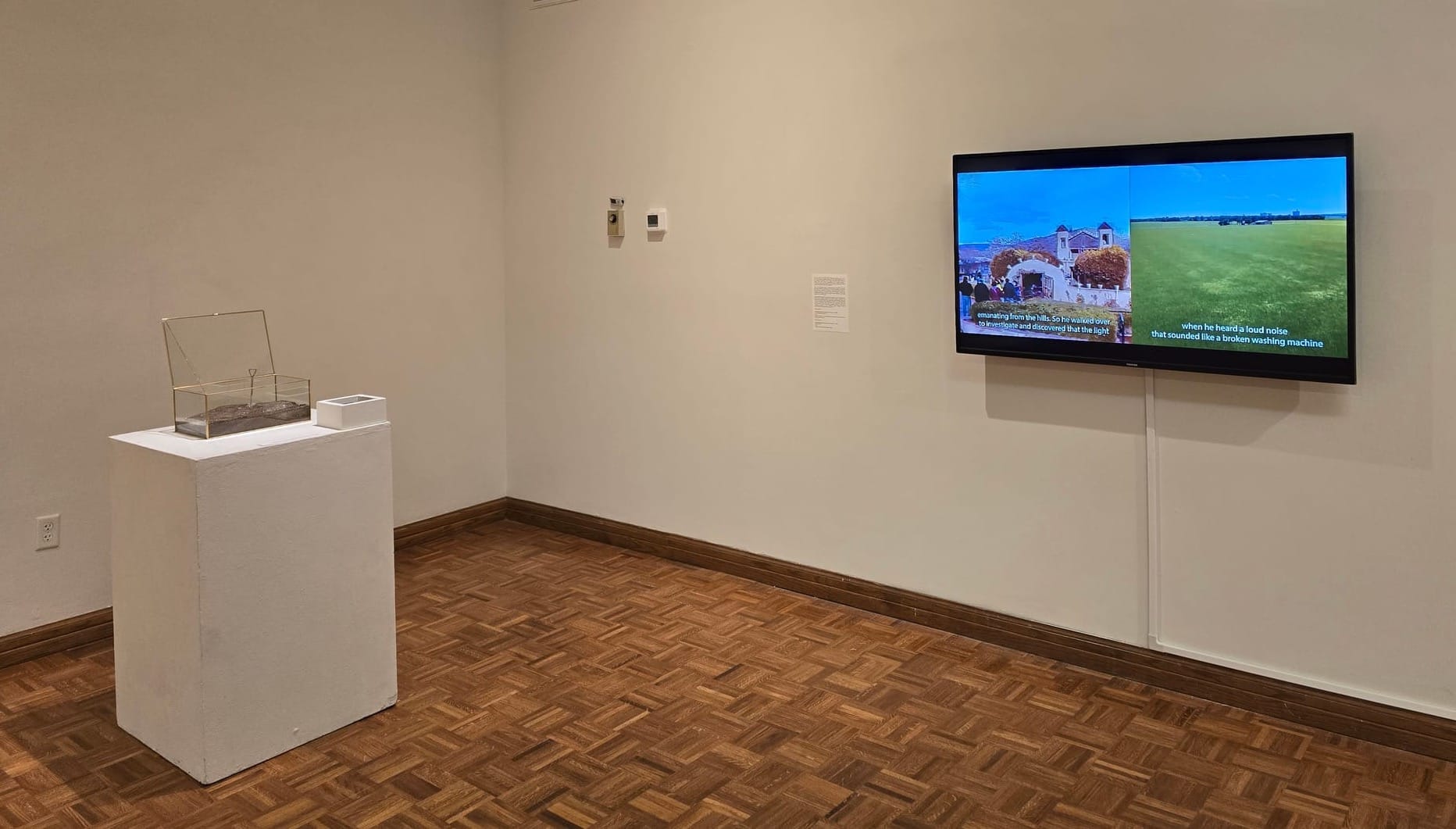
"There are traces that once followed leave indelible paths of desire …" integrates a 3-D model of a church in Pilsen, Kansas associated with Chaplain Emil J. Kapaun. The priest’s supporters have worked to advance his sainthood due to reported miracles. Another 3-D printed model of a place of worship on Mars faces the church. The artist copied this structure from an illustration made by a man whose accounts of his interplanetary travel are preserved at the Geneseo City Museum in Geneseo, Kansas. Zelada-Romero places these models at the corners of a walkable synthetic turf crop circle/labyrinth from which a soundtrack emanates.
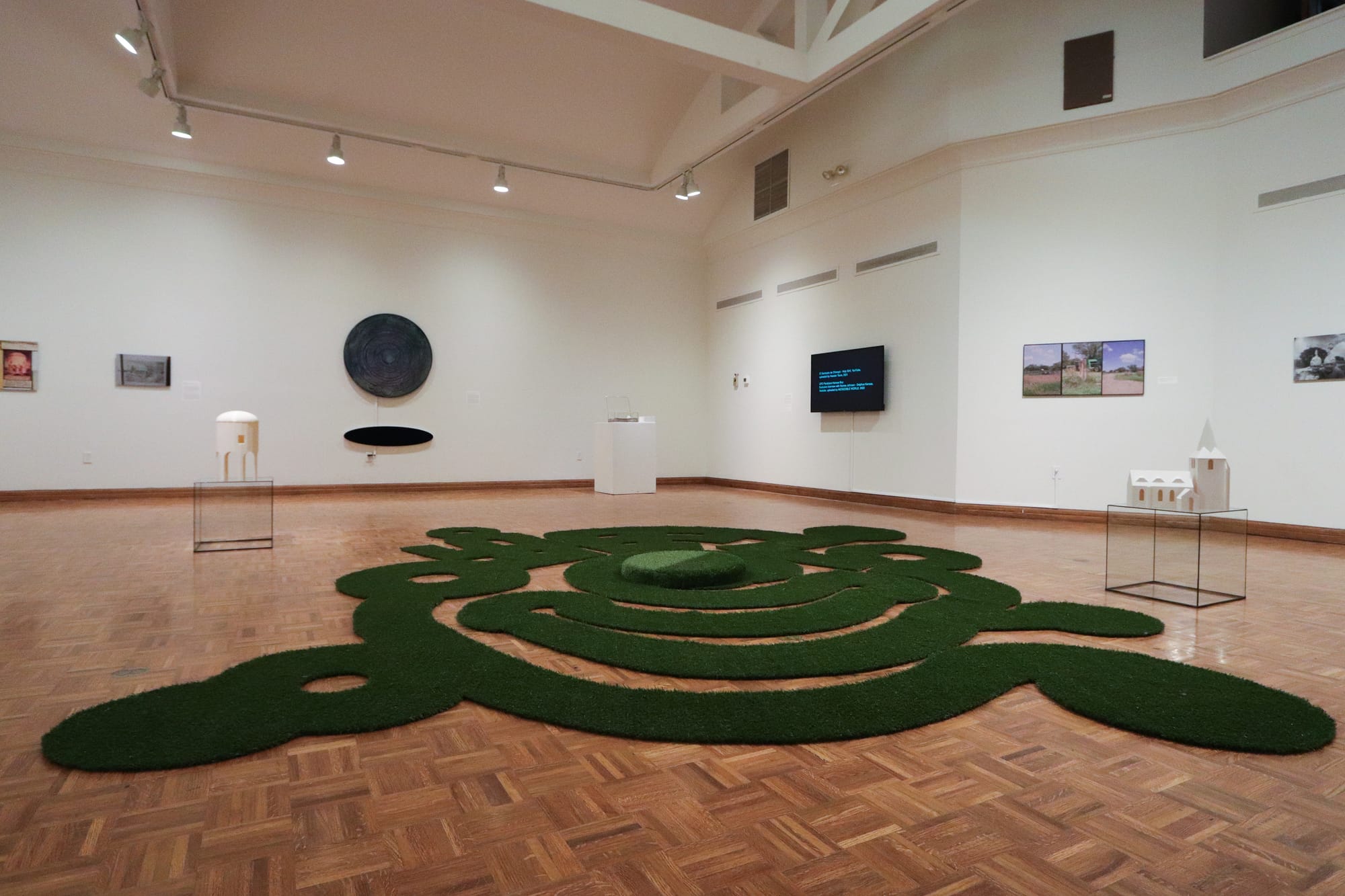
In an interview published in the exhibition catalog, Zelada-Romero says that he intends the sculpture and installation to “close the gap that the photographs create between viewer and landscape, encouraging navigation and interaction instead of passive observation.”
Subscribe to our free email newsletters
Stay in the know about Wichita's arts and culture scene with our Sunday news digest and Thursday events rundown.
No spam. Unsubscribe anytime.
Terry Evans
The photographs in Terry Evans’s exhibition should be familiar to Salina audiences because of her decades of living and working there. Her aerial images of the prairie as well as her work with The Land Institute and her photographs held in major museum collections across the country demonstrate Evans’s rigorous discipline to understand with the camera.
In a statement that accompanies “Tales of Dakota Sandstone,” installed in a small gallery where the scale of the room encourages contemplation, Evans writes, “When I first started photographing a pristine prairie back in 1978, I thought that if only I could understand the biological structure of a prairie ecosystem, I might understand the structure of the universe. But now I wonder if looking at anything long enough and hard enough might reveal the structure of the universe?”
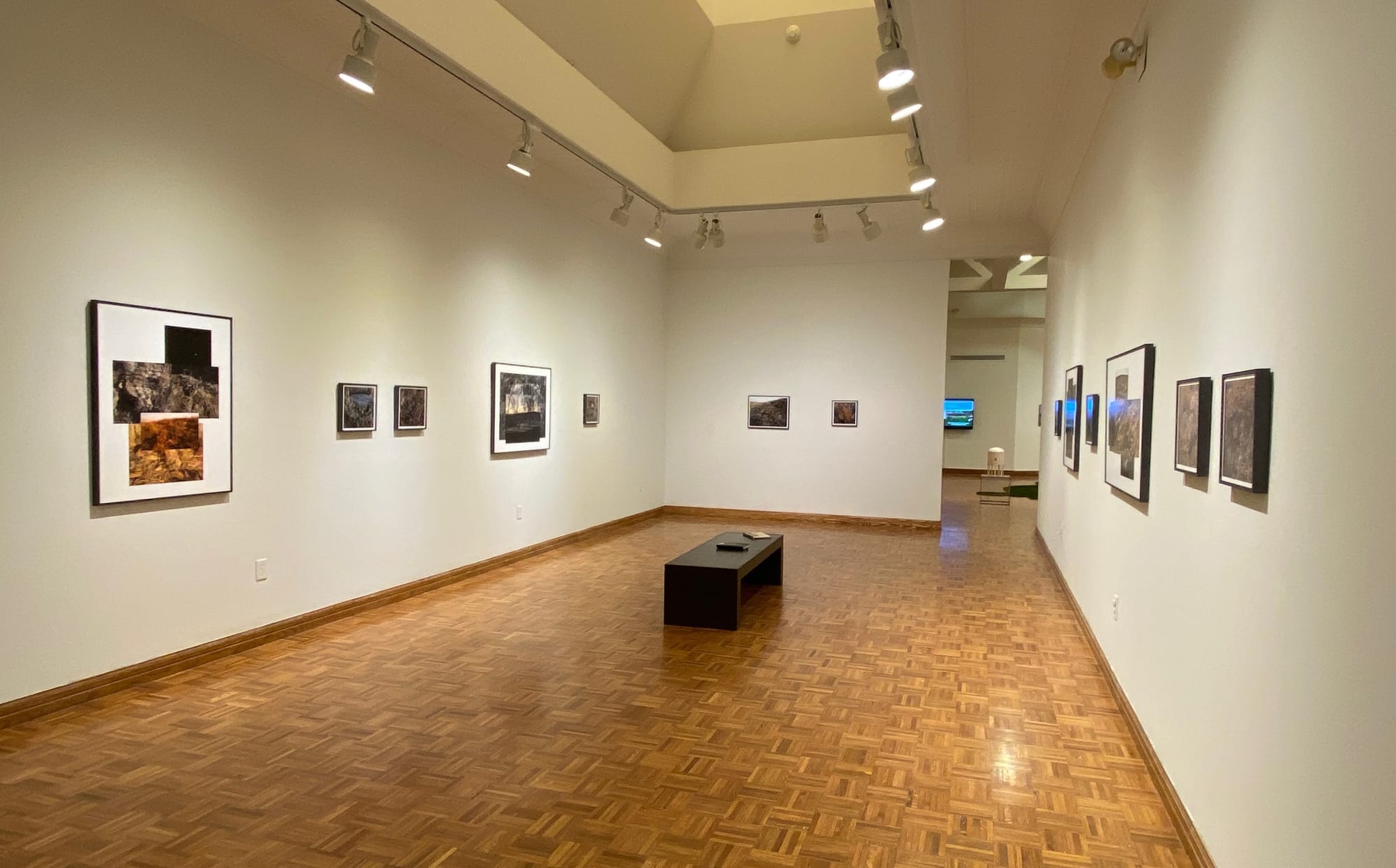
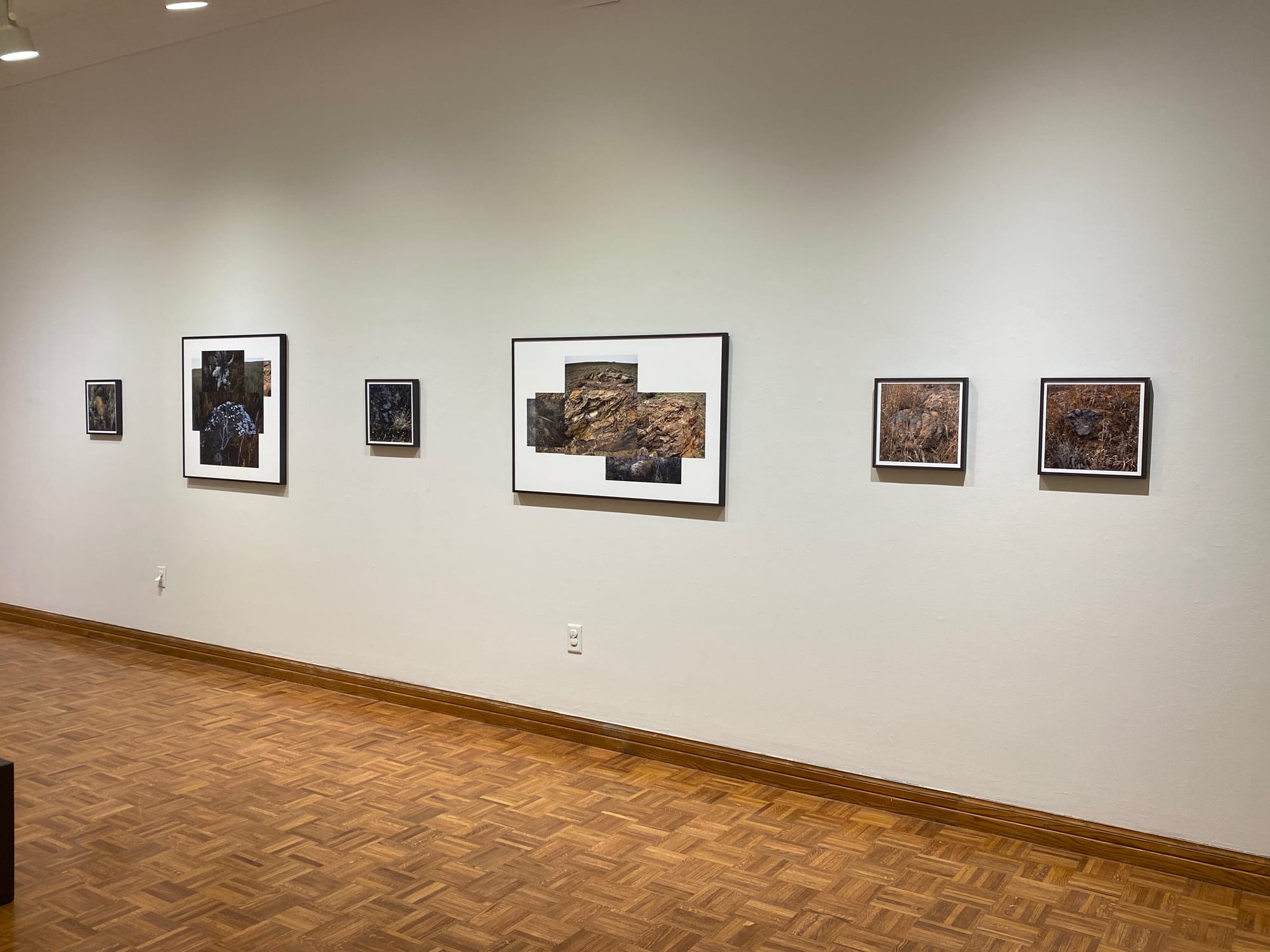
Installation views of "Tales of Dakota Sandstone," an exhibition by Terry Evans, in the Salina Art Center gallery. Photos by Lori Brack for the SHOUT.
This “preposterous” and vulnerable idea — that the land she has known for 50 years, overtaken by cedar trees and evidence of their burning, might also reveal the connections between all of us — propels these 13 photographs. She looks again at the known pasture and finds it also, simultaneously, unknown. These images from a Kansas pasture show a place made new by looking differently, and looking with care. Evans’s photographs communicate a requirement to say something about the diversity of nature and the universe, nestled alongside the private, idiosyncratic embodied experiences of a single individual.
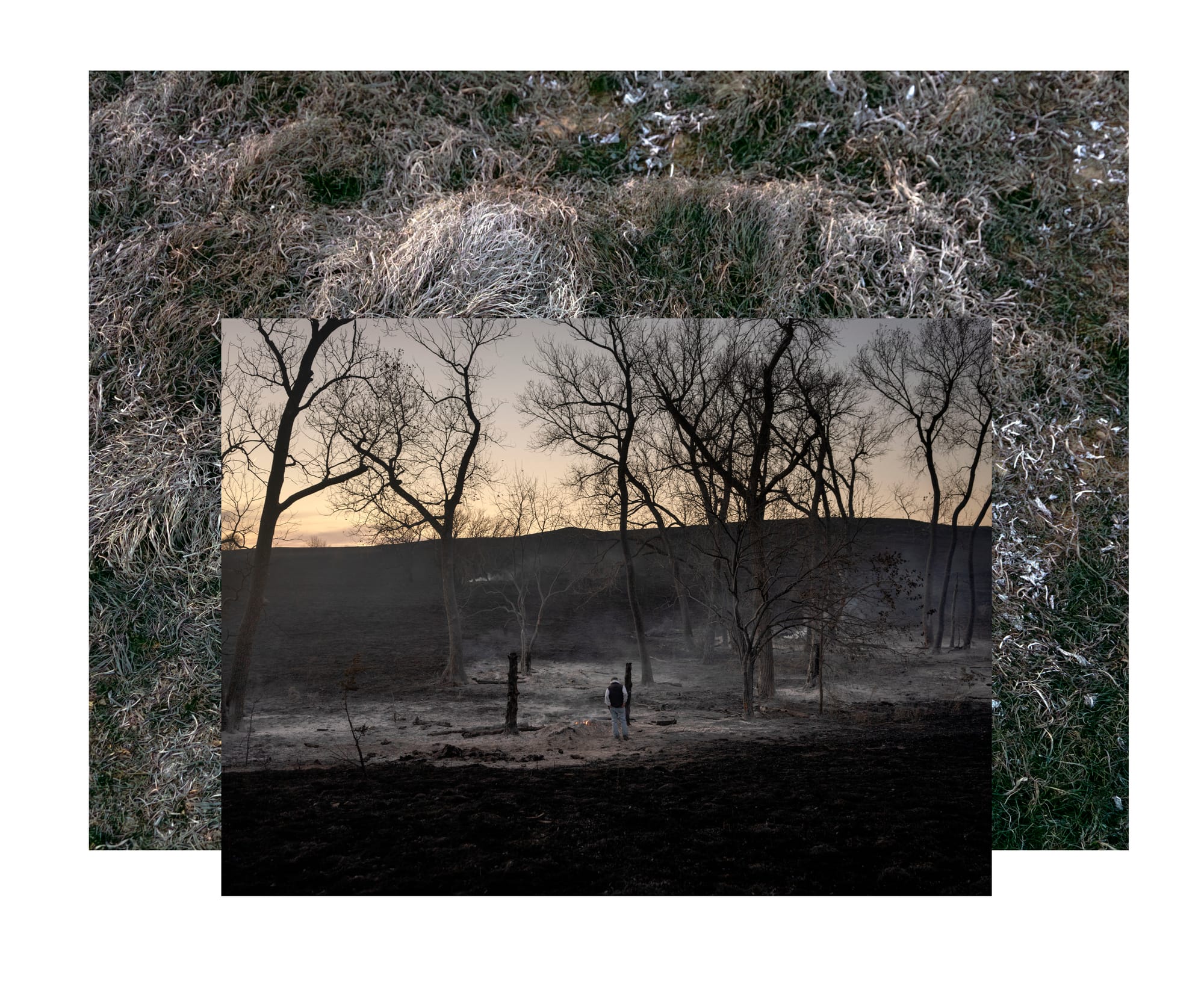
A layered piece, “One hundred million years and one hundred and forty thousand miles,” made of four overlapping photographs, takes the eye from golden and red sandstone in full sun, up through a spine of dusky rock to the black night sky with a small dot of moon mirroring the golden-red hues of stone. This and other large pieces suggest the kind of passage of time we can understand — a day, a season.
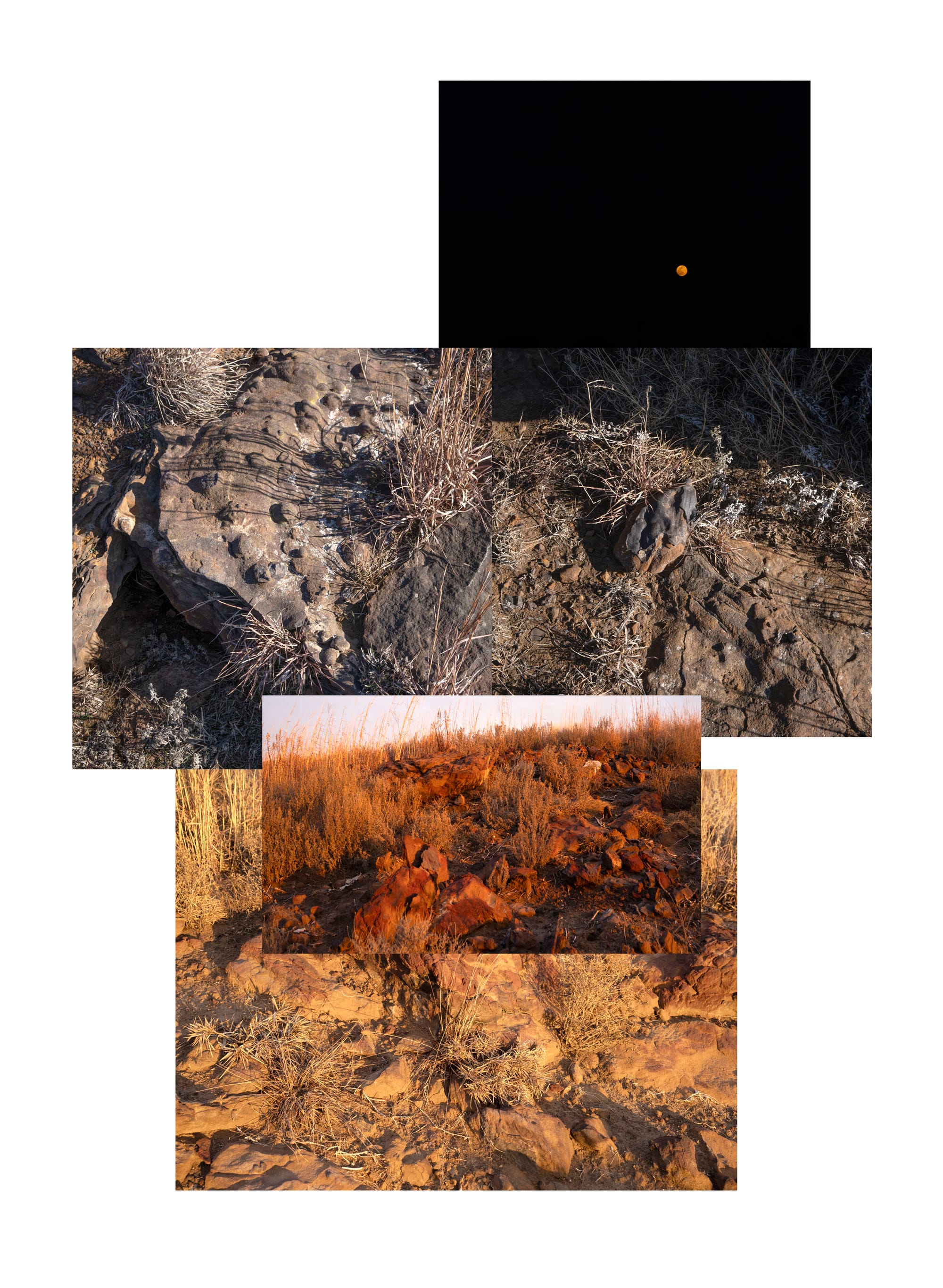
Evans’s photographs of individual stones nestled in prairie grasses offer portraits of eons. Ripples in Dakota sandstone are 100 million years old, and the stones themselves settle in like unrecognizable yet familiar animal or human bodies. Understanding and strangeness seem held in the bedrock matter we are made of by the breath and the heartbeat of water, wind, and epoch. As Evans looks down and finds traces of our deep past, she concludes, “We are all connected.”

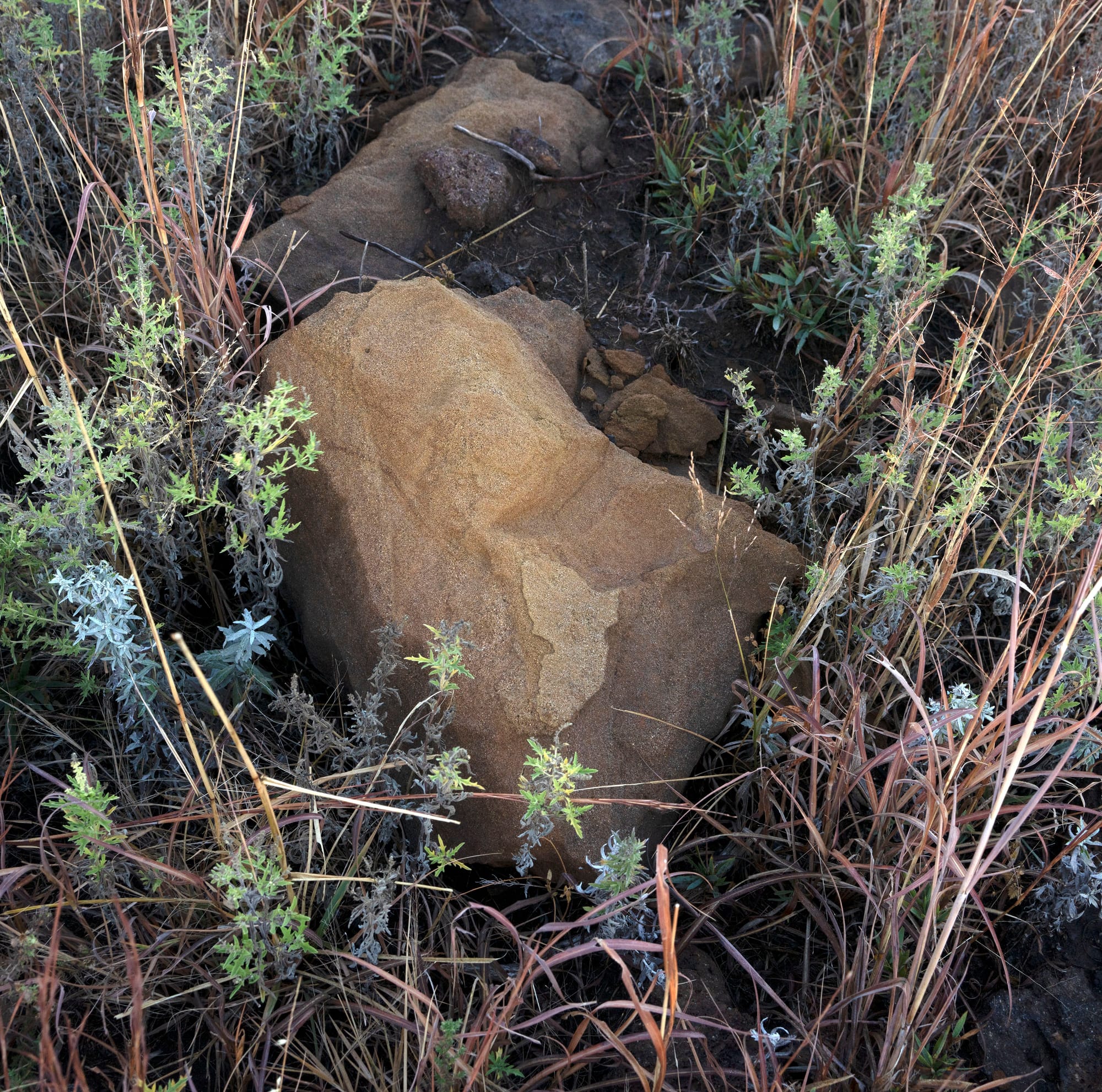
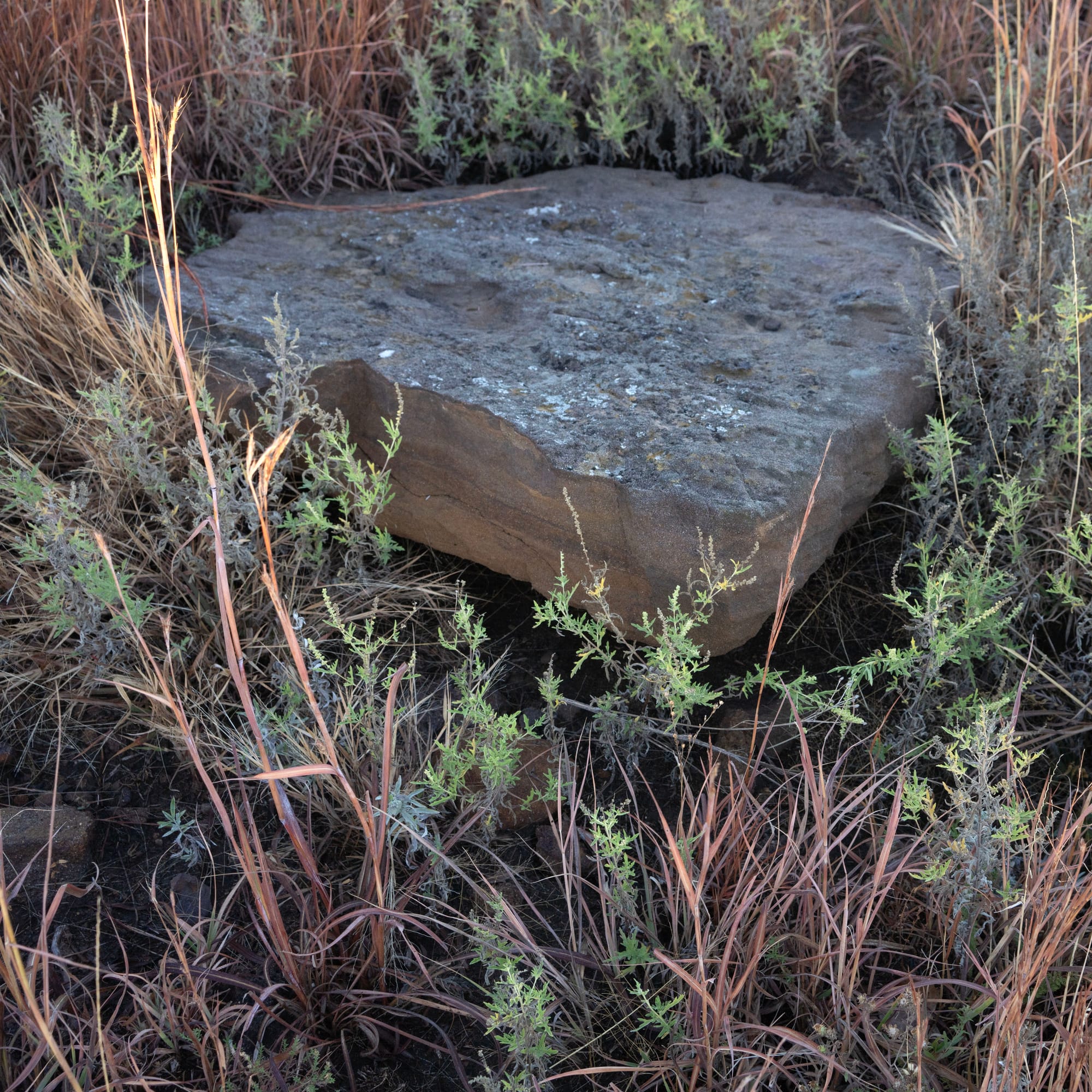
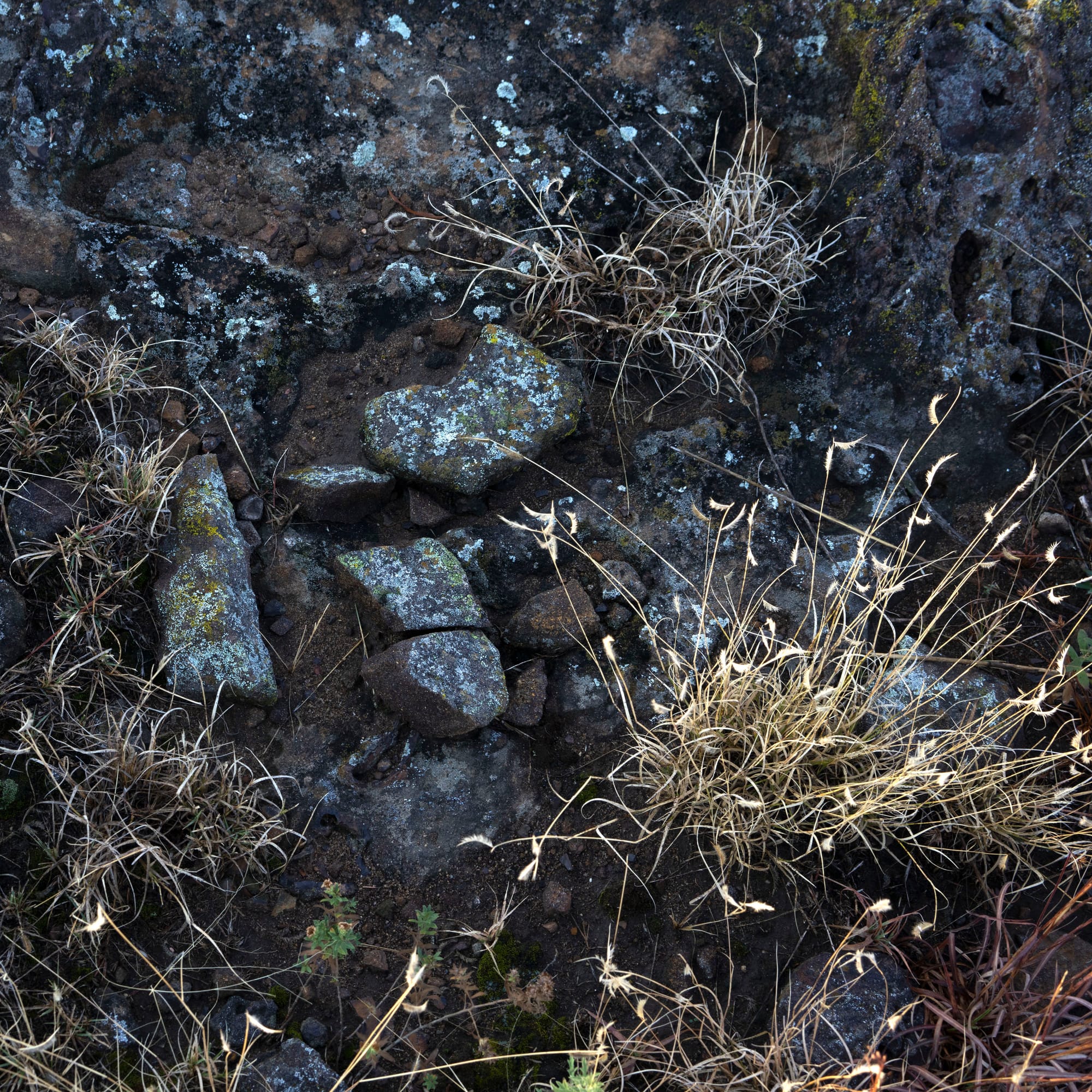
Photographs by Terry Evans, from top left: "Patterns, 17 by 22 inches; Untitled 1, 2, and 3, 12 by 12 inches each. Images courtesy of the artist.
In his catalog interview, Zelada-Romero addresses Kansas geography, too. “In Kansas, I think the landscape itself plays a role — the vastness, the emptiness, the exposure. The sky is enormous ... The photographs are a way to re-enchant the landscape for myself and others.”
“High Strangeness” is concerned with the enormity of space and “Dakota Sandstone” is committed to the significance of earth. Both point toward structures of the universe from perspectives and human experiences right here. Narratives presented and suggested in both exhibitions may have been hidden or ignored, but all three artists and their subjects require us to look, listen, and to engage in trusting the stories they tell.
The Details
“High Strangeness: Encounters with the Unexplained in Kansas and Beyond” and “Tales of Dakota Sandstone: Terry Evans”
May 28-August 31, 2025 at the Salina Art Center, 242 S. Santa Fe in Salina, Kansas
The Salina Art Center is open to the public Monday and Tuesday by appointment, 10 a.m.-5 p.m. Wednesday-Saturday and 10 a.m.-2 p.m. Sundays.
Admission to the Salina Art Center is free, as are most events, except where noted. Find more exhbtion-reated events on the Salina Art Center's website.
7 p.m. June 18: Campfire Stories” artist talk and tour with curator Ksenya Gurshtein and artist Hugo Zelada-Romero, followed by s'mores on the patio.
5 p.m. June 27: Artist Talk with Terry Evans as she discusses the ideas and images behind "Tales of Dakota Sandstone."
9 a.m.-5:30 p.m. June 28: Summer Road Trip ($65): Join the Salina Art Center for a day trip exploring Kansas art and oddities — including the Geneseo UFO Museum & Mural with Jim Grey, lunch at Fly Boy Brewery in Sylvan Grove, and an afternoon at the Grassroots Art Center with free time in Lucas. This event is limited to 20 people.
6 p.m. August 28, location TBA: Experience a powerful live performance of first-person UAP accounts, collected as part of this immersive storytelling project exploring the unexplained.
Dates for the related summer film series, featuring "Close Encounters of the Third Kind," "Batteries Not Included,"and "Super 8" on the Art Center Cinema page. Regular theater admission is $13.25.
Lori Brack is a writer and arts worker based in Lucas, Kansas. She is the author of three books of poems and many essays in anthologies and journals. Links to her writing and full bio are at www.loribrack.com.
Support Kansas arts writing!
The SHOUT is a Wichita-based independent newsroom focused on artists living and working in Kansas. We're partly supported by the generosity of our readers, and every dollar we receive goes directly into the pocket of a contributing writer, editor, or photographer. Click here to support our work with a tax-deductible donation.
❋ Derby man has the kind of voice that turns heads — and chairs
❋ Socializing while sober: how some Wichitans are cultivating alcohol-free communities
❋ As a small creative business closes, the owner mourns
❋ Painting through it: Autumn Noire on 20 years of making art
❋ How a guy from Wichita resurrected 'Dawn of the Dead'
❋ Bygone Friends University museum housed curious collections
The latest from the SHOUT
 The SHOUTKevin Kinder
The SHOUTKevin Kinder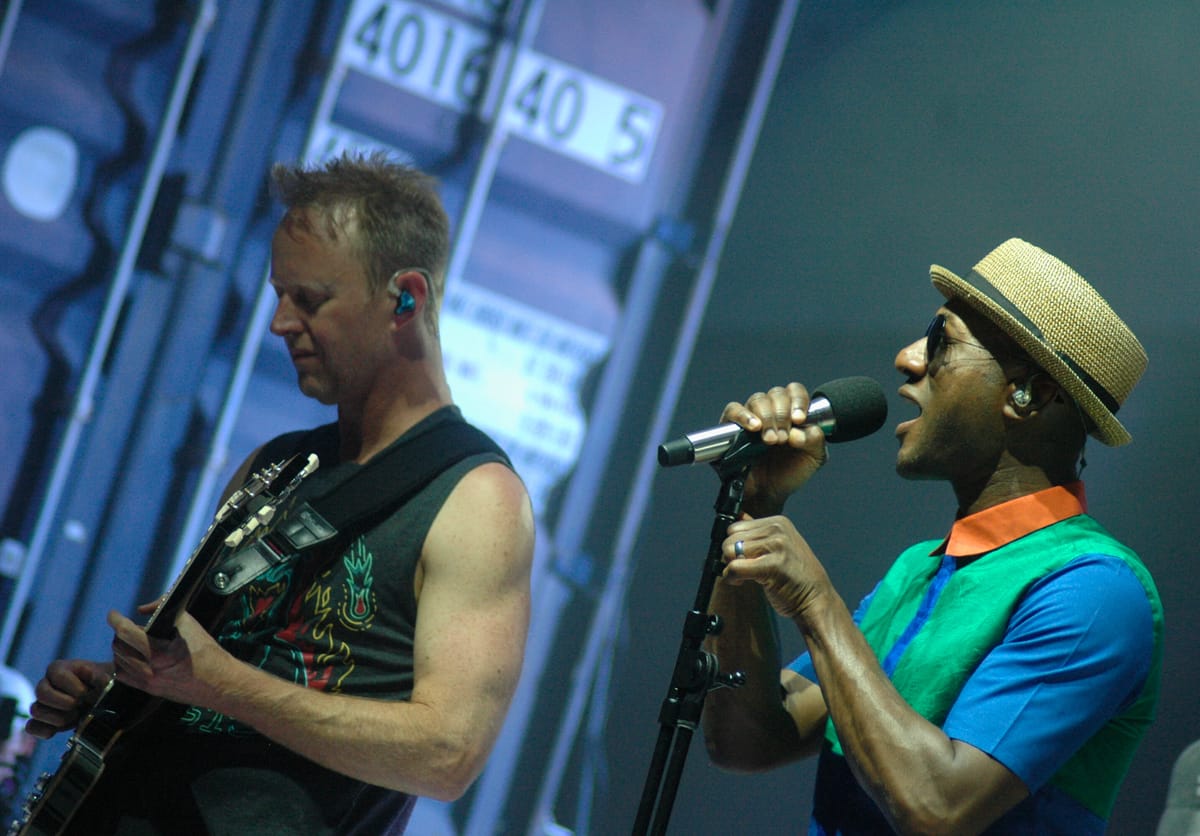
 The SHOUTShelly Walston
The SHOUTShelly Walston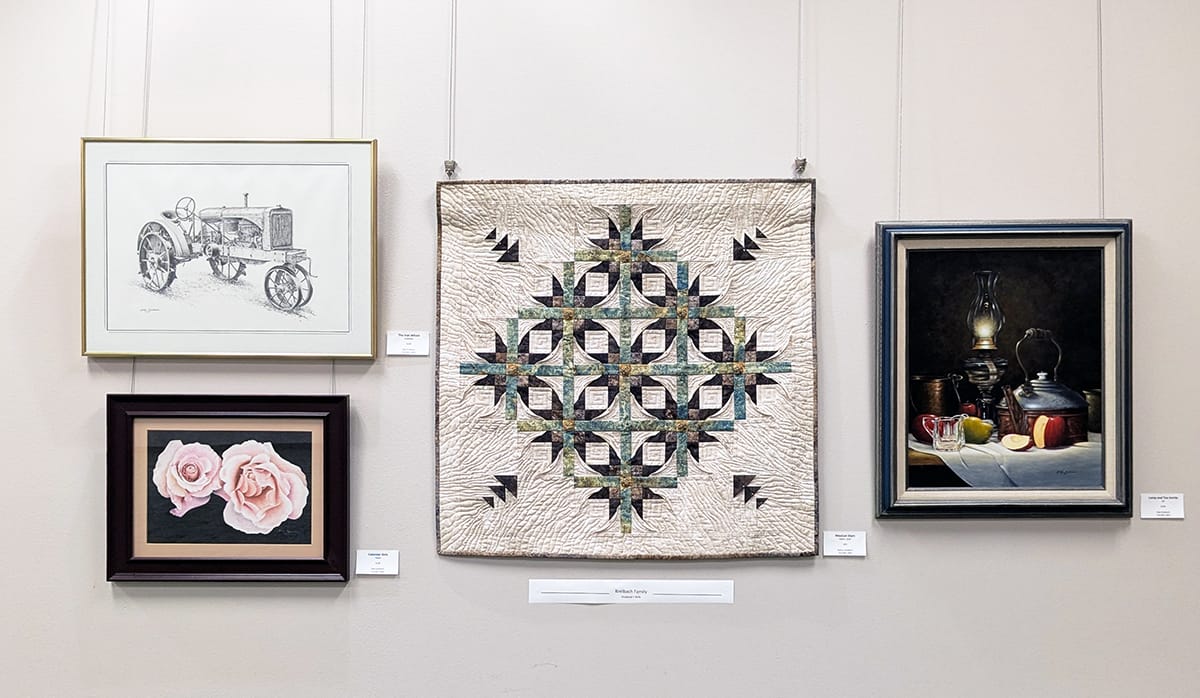
 The SHOUTKate Storhoff
The SHOUTKate Storhoff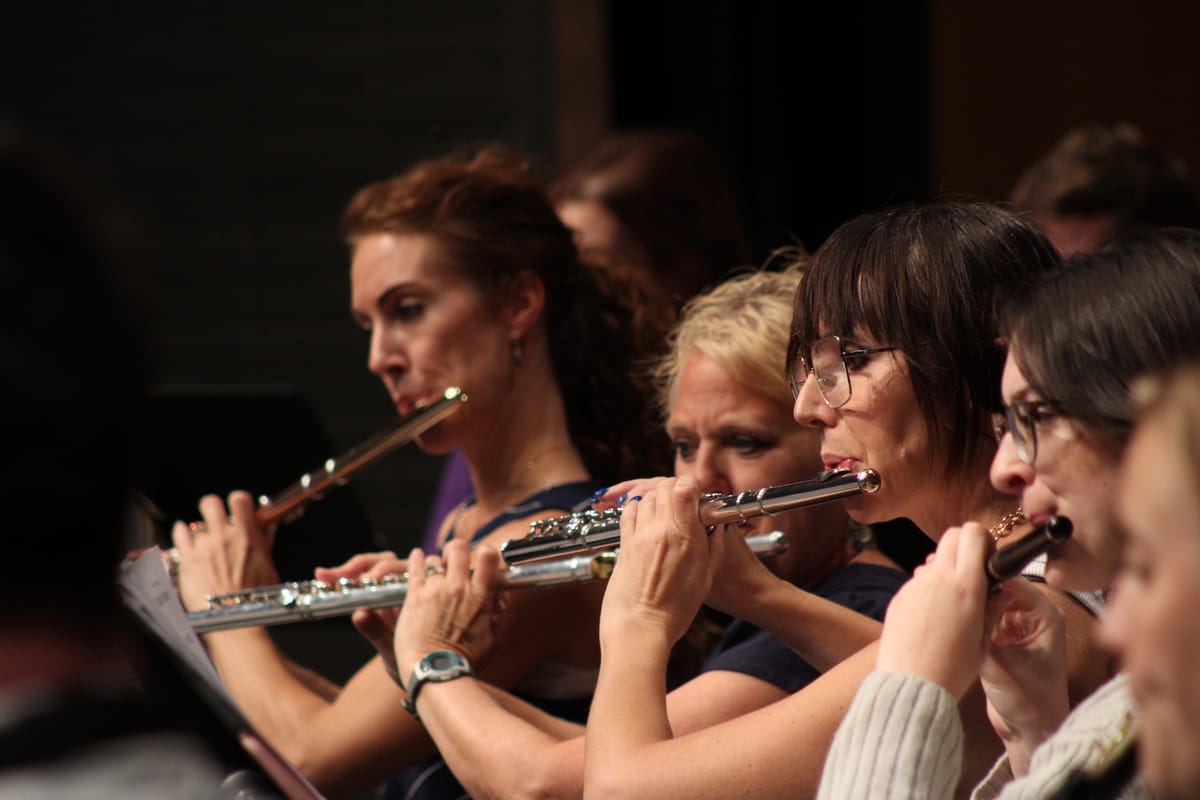
 The SHOUTKevin Kinder
The SHOUTKevin Kinder